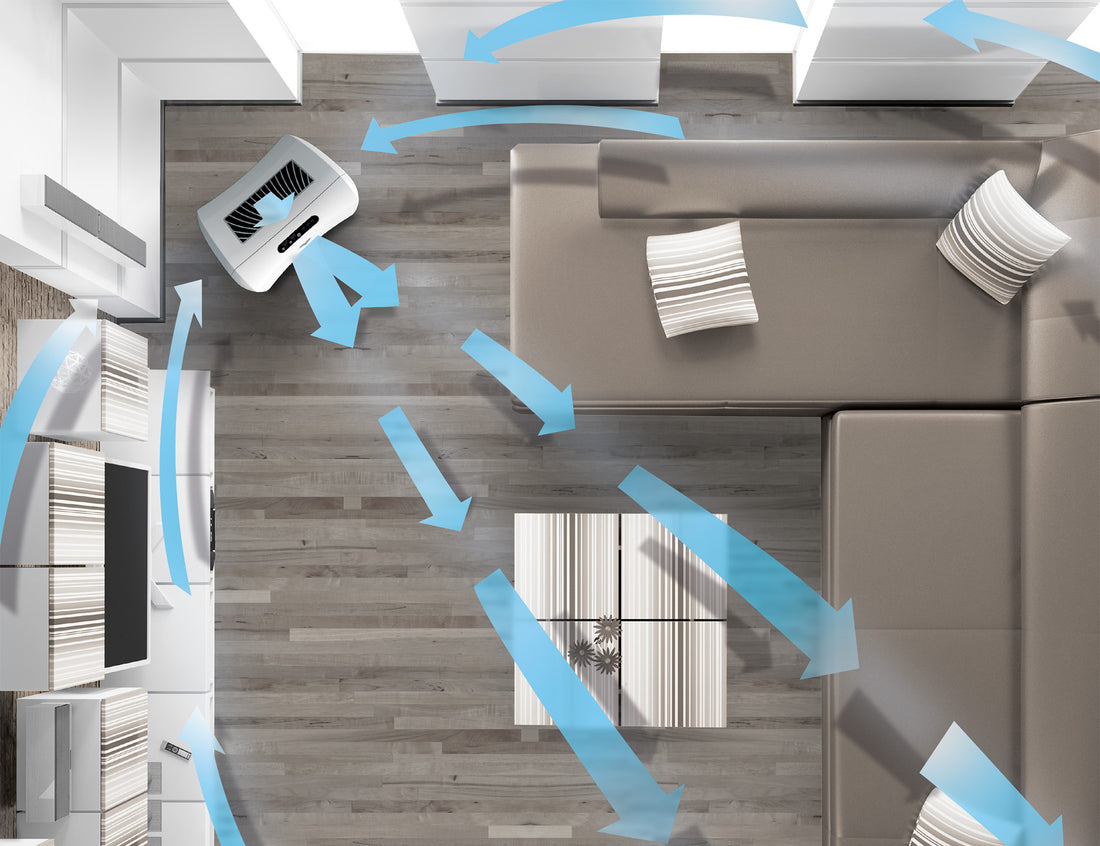Choosing an Air Purifier – CADR Ratings, Room Size and Filters
What Is the CADR Rating?
Before we can look at the pros and cons of CADR, it’s important to first understand what is CADR and how it is calculated. CADR stands for Clean Air Delivery Rate and the metrics are given in three categories: dust, smoke and pollen. In each category, the CADR rating measures how many cubic metres of air a given air purifier effectively removes each type of particle every hour. The higher an air purifier scores in a given category, the more efficient it is at removing particles in that size range.
How is CADR Calculated?
To calculate CADR, an air purifier is placed in a room measuring 20 square metres. The air purifier is then allowed to run for 25 minutes. After the 25 minute test, the levels of the three contaminants the test is designed for are measured against the pre-test levels. In this way, an objective measure of how well the air purifier removes the different particle sizes can be calculated.
What are the benefits of a CADR measurement?
A CADR allows potential buyers to objectively compare air purifiers when making a purchasing decision. Unlike measurements such as air flow rate and overall capacity, the CADR provides a specific measurement of how well an air purifier does in filtering out particles of different sizes. The objective nature of a CADR rating makes it much easier to tell how well an air purifier will perform when compared with other units that have undergone the same testing.
CADR ratings are also useful because they show you how well an air purifier can remove several common contaminants. If your main aim in using an air purifier is to remove pollen from your home air, for example, you can select a unit that has a high pollen CADR rating but may perform less well when it comes to removing smoke. Thanks to the three-category nature of the test, consumers can select the air purifier that best suits their unique needs.
Why should you look at more ratings than the CADR rating when buying an air purifier?
For all of their advantages, CADR ratings don’t tell you everything about an air purifier. One of the biggest CADR limitations is the fact that the test does not include gases, odours or VOCs. These non-particulate contaminants are very common in home air and can be targeted by air purifiers that use carbon filters. Many air purifiers that carry CADR ratings use HEPA as well as carbon filters. When these air purifiers are submitted to the CADR test, only one part of their filtering capabilities is actually being measured. So, if gaseous contaminants are part of your home air quality concerns, a CADR test should not be the only metric you use in picking out an air purifier.
CADR is also the standard commonly in use within the United States where CADR Ratings are provided by an official body after standardised testing of an air purifier. While no such standardised testing exists in Australia, manufacturers do provide air flow ratings which can be used.
Air Changes per Hour (ACH)
A metric which is closely related to CADR Ratings of an air purifier is its Air Changes per Hour. Air Changes per Hour measures the hourly volume of clean air delivered by an air purifier expressed as a multiple of the volume of the room. A good air purifier should be able to deliver in 15 minutes, a volume of clean air that is equal to the volume of the room. This implies a minimum ACH of 4.
Not all Australian air purifier suppliers note their ACH. In these cases, the room size that can be covered by an air purifier can be determined by the thumb rule which states that the maximum room size that can be covered by an air purifier is no larger than 1.5 times its CADR Rating.
What else should consider when buying an air purifier?
First and foremost among these is the kind of air purifier you need. As stated above, air purifiers with HEPA filters target particles, while those with carbon filters target gases. If you want to filter out both classes of contaminants, you’ll need an air purifier that combines these two filter types. Deciding what contaminants you’re most concerned about and choosing your model accordingly is arguably the most important step in buying an air purifier.
You’ll also need to think about the size of the space your air purifier will be used in. As you can imagine, a unit capable of covering a mid-sized house must be able to cycle air much more quickly than a unit that covers a studio apartment. In addition to CADR, you should be looking at the CMH (cubic metres per hour) of air flow and the unit’s square footage rating to determine what unit is best for your needs. Keep in mind that unless stated otherwise, most air purifiers’ square footage ratings are calculated on the basis of one air change per hour in a space with 2.4m ceilings (Australian standard ceiling height).
Finally it’s also important to consider the noise level you’re comfortable with. Many air purifiers can operate very quietly on their lower fan settings. Lower fan speeds will reduce the functional clean air delivery rate. Try to find a unit that offers a good balance between your noise comfort level and efficient filtering. Ending up with a unit that’s too noisy, even if it means better filtration, can be a serious annoyance and make you less likely to keep using an air purifier over time.
Conclusion
As you can see, an air purifier’s CADR or ACH rating are valuable metrics in choosing the right unit for your home, but it shouldn’t be the only thing you think about. Be sure to consider square metreage, additional features, CMH ratings, filter types and other factors as well. Picking the right air purifier is often a bit of an involved process, but the results can be well worth the effort.
What are the Vornado AC350 Air Purifier CADR metrics?
The Vornado AC350 Air Purifier metrics:
CADR - Cubic Metres per Hour (CMH)
Pollen – 270
Dust – 234
Smoke – 194
Clean Air Delivery Rate (CADR)
Recommended Room Size – 20sqm
Pollen - 5.5 air changes per hour
Dust – 4.81 air changes per hour
Smoke – 3.98 air changes per hour

